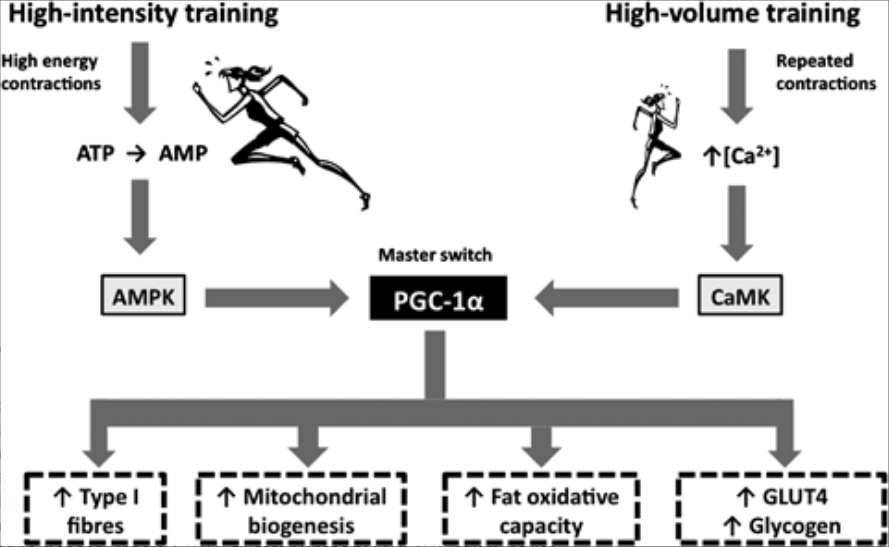Every endurance athlete—cyclist, runner, triathlete, or otherwise—has pushed through a set of intervals, thrown down at a local race, or suffered through a Strava segment. We know the distinct feeling that comes with going hard: our head cocked sideways, pain oozing from every pore, legs screaming at us to stop. And we also know the satisfaction of executing a full set of intervals, hitting a new PR, and feeling the accomplishment of a hard-fought workout.
As athletes, we crave intensity. There’s a good chance our next high-intensity training (HIT) session is never too far away or out of mind. What’s problematic, however, is that there are few subjects in endurance sports that are surrounded by as much mystique or as many misconceptions. The world is awash with articles suggesting that you’re not doing enough intensity or that you’re doing it the wrong way.
So let’s dive into the science of HIT and dispel those myths, correct those misconceptions, and provide a more complete understanding of the benefits and limits of high-intensity training.
Misconceptions of HIT
To be at our best, athletes need HIT work. In fact, we need a lot of it. But effective HIT work isn’t just about quantity, nor is it about hitting peak numbers. The two most important concepts in effective HIT training are balance and purpose. In other words, it’s about how HIT fits into your overall plan and what you’re trying to accomplish with each HIT session.
But before we go there, let’s dispel a few of the misconceptions about HIT.
Worst among the myths is the “no pain, no gain” mindset—the notion that if it doesn’t hurt, we aren’t getting any benefit. Yes, interval work should hurt. Depending on the intervals, they can hurt a lot. But not all work needs to, or even should, hurt.
As I’ll soon explain, training is about working energy systems, and only some of our energy systems adapt when we go hard. If you aren’t balancing intense training with easy workouts, you’re neglecting important systems. You may also start pushing overtraining or find yourself always working at a rate that leaves you neither fresh nor sufficiently depleted and, therefore, unable to come back stronger.
It’s worth mentioning that, on the opposite end of the spectrum, there is the long-slow distance (LSD) myth. Have you ever heard a coach argue against the need for base training on the basis that doing only easy rides will make you slow? This argument assumes that base training should exclude HIT work, which is a fallacy.
Training is not an either-or proposition—either all HIT work or all LSD rides all the time. Effective training comes from a balance of the two.
The energetics of HIT
When physiologists talk about training, we often refer to developing our energy systems. That’s a bit of a simplification. In reality, there are only three energy systems: phosphocreatine, anaerobic, and aerobic.
Training adaptations target a much broader milieu including mitochondrial density, lactate clearance, hydrogen ion buffering, vascular capillarization, fat oxidation, stroke volume, neuromuscular recruitment, muscle fiber conversion, reactive oxygen species buffering, not to mention mental toughness. [1–9]
Most of these systems are not energy systems themselves. However, adaptations in these areas ultimately improve our ability to metabolize and use energy. Thus, we simplify them to the general term “energy systems.”
To train an energy system, it needs to be stressed enough to force an adaptation. And for many energy systems, particularly the one’s needed for racing, the only way to produce the needed stress is with tongue-hanging-out HIT work.
A few of those race-critical energy systems that can only or mostly be trained by intensity include our lactate threshold, anaerobic capacity, VLamax, lactate clearance, sprint power, and hydrogen ion buffering. We often talk about VO2max, but VO2max plateaus early in our careers and ceases to be highly trainable. [10,11]
“VO2max tends to peak pretty early,” says exercise physiologist Dr. Stephen Seiler, who popularized the polarized training concept. “And people tend to overtrain it. That’s where we get into all this interval training. They do a lot of work to keep trying to pound that VO2max, but it’s just not going to keep climbing.”
So, while focusing on training our VO2max may not be a great use of HIT training, there are still many systems that are very effectively addressed with intensity. The danger is in trying to maximally stress all systems at once.
“That’s the main issue,” says Sebastian Weber, founder of INSCYD. “You are maxing out different systems, you’re maxing out your creatine phosphate stores because those will be depleted at the end of the exercise. You are maxing out your pH levels; you are most likely maxing out your lactate concentrations.”
Stressing a system causes damage, and it’s in the repair process that we get stronger. Do a little damage, and your body will repair to where it was. The goal is to do enough damage for the body to say, “I didn’t like that,” and not only repair but “super-compensate” so it can better handle that same stress in the future.
If, however, you do too much damage, you overwhelm the body and can end up weaker or overtrained. So, if you target all systems at once, then you either create just a bit of damage to each and get no supercompensation; or you do so much total damage that your body is overwhelmed.
A more effective approach is to focus your high-intensity work on specific energy systems and only stress a few key systems at a time. This is why we have many different types of interval work: threshold intervals, Tabata intervals, anaerobic capacity work, sprints, and so forth. Through years of experimentation, each type has been found to very effectively target a system.
So, part of the art of effective HIT work is to carefully pick your work.
“When we’re truly talking about unstructured intensity, I think that that is when it gets messy,” says professional mountain biker Hannah Finchamp. “You’re no longer targeting your energy systems, you’re not following a polarized approach, you’re not following a periodized approach. You just can’t mix and match so many energy systems where you’re going for a 10-second segment, and you’re also going for an hour-long segment, and expect to have the same outcome as someone who’s being very thoughtful in all their intervals and strategy for their workouts.”
The limits of HIT
If HIT work is an essential part of training the energy systems critical to racing, then why wouldn’t we do HIT work all the time and maximize the stress?
The answer is not simple.
To get at the answer, we first need to understand how our bodies initiate adaptations. Many of the energy systems that make us better endurance athletes are regulated by a single signaling molecule called peroxisome proliferator-activated receptor-gamma coactivator (PGC-1α).
While PGC-1α is the master regulator, it can be activated by four different pathways. The two that are particularly relevant to training are the adenosine monophosphate kinase (AMPK) pathway and the calcium-calmodulin kinase (CaMK) pathway (figure 1). [4,12–15]

In his review “Training for Intense Exercise Performance: High-Intensity or High-Volume Training?”, Dr. Paul Laursen explains that HIT mostly acts through the AMPK pathway, which rapidly produces adaptations (within four to six weeks) but plateaus equally rapidly.
Long, slow endurance training produces its effects primarily through the CaMK pathway. These adaptations take longer to develop (months to years), but seem to produce much bigger improvements in the long run. Dr. Laursen points out that the two pathways appear to have an additive effect on one another.
“When training does not have an appropriate blend of both high-intensity and high-volume training inserted into the program, performance ability can stagnate,” wrote Laursen. Ultimately, we need a balance of both. [12, 16]
Seiler has seen the importance of this balance, and has even witnessed the benefits of limiting HIT workouts, in his research with athletes [16–18]:
I often talk about fresh fruit. A lot of athletes are interested in their anaerobic capacity, their lactate tolerance, and they do these super high-intensity intervals. And you do get adaptations, if you haven’t been doing some kind of really high-intensity interval training. The thing about it is it only takes a few weeks: You can get a big improvement, a 10 percent improvement or so, in as few as four workouts, if they’re well executed. But they’re costly. And they’re fresh fruit because that adaptation is what I would call a soft adaptation. It’s some proteins in your blood and in your intracellular space, it’s some changes in buffering, it’s stuff that both comes pretty fast, but it goes away pretty fast. And it’s really costly to maintain, because you have to do these really high-intensity efforts that cause a big stress response. So, we’re going to time that training; we’re not going to do it at certain times of the season when we don’t need that little turbo. That long haul stuff—the low intensity, the volume—those adaptations, research shows us, maintain longer capillary density. It seems it is infrastructure that’s being built, the lattice work, and it doesn’t decay as quickly as those soft adaptations.
I’d submit this theory: Adaptations can take two forms, biochemical and structural. For example, one of the most important improvements in endurance athletes is an increase in stroke volume—the amount of blood the heart pumps per beat. There are two ways that stroke volume can be improved. One is to increase the size of the left ventricle (structural). The other is to increase blood volume (biochemical).
It appears that many of the adaptations caused by HIT work tend to be biochemical. For example, it has been shown that HIT work tends to increase blood volume. [20] The adaptations from long, slow distance may be more structural, which is why they take much longer to develop but can produce much bigger gains. [19] Biochemical adaptations can only do so much, and they tend to disappear as soon as you stop training them.
Therefore, HIT work alone will not produce the long-term adaptations you want.
What’s worse, as Seiler has demonstrated, is that HIT work produces a form of damaging stress called autonomic stress. This type of stress takes longer to recover from and has been shown to contribute to overtraining syndrome when an athlete is exposed to too much. [21, 22]
Seiler found that two HIT sessions per week were optimal to balance adaptations with the negative effects of autonomic stress. Three sessions per week had no additional gains, and more than three quickly led to over-reach and overtraining. [16, 23]
All of this has led coach Grant Holicky to point out the importance of balancing high-intensity training with easy work.
“The one [mistake] that jumps out at me is always making the easy too hard and making the hard not hard enough,” Holicky says. “Training is about working the edges of the system. It is shown in many studies that base training, which is a little bit easier, and tempo training, which is that no man’s land, actually are going to give you a similar physiological response. It’s just that one of them makes you more tired. So, the hard training gets diminished down a little bit. The easy training gets lifted up a little bit. And we live in moderato and we’re not going to get that return out of that medium place. Make your hard efforts super hard and make your base training and your easy days super easy.”
Picking your HIIT work
So far, we’ve been talking about HIT, which stands for high-intensity training. In the literature, there is a differentiation between HIT and HIIT, which is important to understand. HIT covers a broad range—as long as you are going hard, you’re generally doing HIT work. It includes intervals, but it also could include training races or hitting a few Strava segments.
HIIT, which is a subset of HIT, stands for high-intensity interval training and refers to more structured work. When you talk about doing your intervals, you’re talking about HIIT. It usually involves some sort of pre-planned routine with periods of intensity (or REPs) separated by rest periods and grouped into a certain number of repeats (or SETS.)
Many factors influence HIIT work including the intensity, the length, the rest period, the number of repeats, the frequency, and even factors like cadence. How these various factors are strung together can have a big impact on the energy systems a HIIT workout targets. [19, 24–30]
This raises an important question: How large of an impact do minor differences in factors such as length or intensity have on the energy system you are hitting?
“I tend to think that our bodies, in how we divide these energy systems and specifically intervals, we’re just not that sophisticated,” says Jim Miller, the director of performance at USA Cycling. “When you tell somebody to do 280 watts, the body really doesn’t know the difference between 278, 275, 283, and so on. So, I tend to dump things into bigger buckets.”
Physiologically, this makes sense. If many of our key adaptations are stimulated by PGC-1α, and all high intensity activates it through the AMPK, then to a degree, if you are activating AMPK, the body doesn’t care if you are doing 15-second intervals at 600 watts or 30-second intervals at 500 watts—to a degree.
Some energy systems are still best stimulated in highly specific ways. For example, a good lactate clearance system is critical to time trialists. Lactate clearance is at its maximum not at high intensities but at around 90 to 95 percent of threshold. So, good time trialists tend to do a fair amount of work in that range.
But, as Jim Miller points out, the different types of intervals fit into a few buckets. And within those buckets the specific interval workout you pick comes down to personal preference more than to differences in adaptations. Let’s look quickly at the most common buckets:
Threshold intervals
While this is the common name, it is a bit of a misnomer. “Threshold” refers to a broad range of intensities, while the focus of this work is to train your maximal sustainable aerobic power. What’s important with this work is doing longer intervals at a steady intensity. Remember that we can produce anaerobic power instantly, but our aerobic machinery takes time to ramp up.
So even if your FTP is 300 watts, if you do an interval at 300 watts, it’ll be a few minutes before you’re truly producing that power aerobically. An ideal length is somewhere between five and 15 minutes. Shorter than that and you get little time with the aerobic machinery fully revved up. Longer than that and it can be hard to find the motivation to put out the power.
VO2max intervals
This is one of the most misconstrued types of intervals, due to the name. They are called VO2max intervals because they are performed at your VO2max power (the power you hit at the end of a VO2max test.) As I’ve already explained, we can’t really train our VO2max, so that’s not the purpose of these intervals.
When riding at that power, you hit your aerobic systems hard, but you also use a lot of anaerobic power. So, more than any other type of interval work, these intervals hit many energy systems, making them a great interval close to peak race season to “touch up” all systems.
Anaerobic capacity intervals
When we talk about anaerobic work, two terms often come up: W’ (pronounced “watt prime”) and VLamax. W’ is a capacity, while VLamax is a rate. It’s useful to think of the analogy of a jar. The size of the jar shows your capacity for anaerobic energy. The size of the mouth of that jar determines the rate at which you can pour that energy out.
For every type of racer, there’s a benefit to having a big jar. But having a big mouth to the jar only tends to be beneficial for sprinters. So be careful about focusing on your VLamax. To increase the size of the jar, there are many options; Tabata intervals are increasingly popular. These are short, all-out efforts with rests that are half the length. The classic Tabata comprises 20-second efforts separated by 10-second rests. So called “40/20s” are very popular among pros.
Dr. Tabata invented the intervals because he was researching W’ and wanted to find an effective way to “empty the jar.” He found it. [31,32]
Sprint intervals
Of all our assets, sprint power is probably the most genetically predetermined. If you have a good sprint, you will probably always have a good sprint. Likewise, if you don’t have a sprint, while you can improve it a bit, it’ll never be great.
That said, there are still benefits to doing this type of work. Sprint work targets a combination of muscle recruitment, strength, and peak anaerobic power. The efforts need to be short—five to 20 seconds—with long recoveries to fully restore your anaerobic stores. Just watch a track rider. They’ll do a sprint and then lie down for 2-3 minutes.
Effective HIIT work
Finally, no matter what type of HIIT work you’re doing, there are a few guidelines that will help you get the most out of your sessions.
Focus on effective execution
While it’s not worth getting too flustered over which specific workout you pick within a category, once you’ve picked it, it is important to execute it effectively. Otherwise, you may not generate enough stress to produce an adaptation.
For example, in the case of 4×8-minute threshold intervals, if you do the first one at 300 watts, the second one at 275 watts, and drop to 225 watts by the last, with each interval the anaerobic contribution is going down, but you’re never truly stressing the aerobic system. It’s important to do all four at the same wattage so that by the fourth you are maximally stressing your aerobic system.
Pick one and stick with it
If you are constantly changing the intervals you do, you run the danger of always “sort of” hitting every energy system, but never hitting any one system hard enough to get a true adaptation.
It’s important to pick a routine and stick with it for several weeks. The higher the interval intensity, the more quickly you see the gains. Sprint intervals produce benefits in as few as three to four sessions. Anaerobic capacity work takes about six to eight sessions, and threshold work can take eight to 14 weeks to produce full gains.
Focus on one or two main energy systems at a time
It takes significantly less work to maintain an energy system as it does to develop it. So, generally it is more effective to focus on one or two main energy systems, fully adapt them, and then maintain them while you focus on the next energy system.
Fortunately, since stimulating the AMPK pathway is going to hit most systems, the systems you have already developed are going to be partially maintained by any interval work you do.
Perform with quality
If you are a stage racer, there are benefits to doing some interval work in a fatigued state, simply to learn how to produce power on the fifth day of a hard race. But generally, to maximize gains, HIT work should be performed when you are rested. And for very hard workouts that produce a lot of autonomic stress, it’s best to rest or only do a recovery ride the next day.
References
- Lucía A, Hoyos J, Chicharro JL. Physiology of Professional Road Cycling. Sports Med 2001;31:325–37. https://doi.org/10.2165/00007256-200131050-00004.
- Skovereng K, Sylta Ø, Tønnessen E, Hammarström D, Danielsen J, Seiler S, et al. Effects of Initial Performance, Gross Efficiency and O2peak Characteristics on Subsequent Adaptations to Endurance Training in Competitive Cyclists. Front Physiol 2018;9:713. https://doi.org/10.3389/fphys.2018.00713.
- Fernström M, Bakkman L, Tonkonogi M, Shabalina IG, Rozhdestvenskaya Z, Mattsson CM, et al. Reduced efficiency, but increased fat oxidation, in mitochondria from human skeletal muscle after 24-h ultraendurance exercise. J Appl Physiol 2007;102:1844–9. https://doi.org/10.1152/japplphysiol.01173.2006.
- Coffey VG, Hawley JA. The Molecular Bases of Training Adaptation. Sports Med 2007;37:737–63. https://doi.org/10.2165/00007256-200737090-00001.
- C. T, D. B, K. L, J. M, G. B. Effects of acute and chronic exercise on sarcolemmal MCT1 and MCT4 contents in human skeletal muscles: current status. Am J Physiology-Regulatory Integr Comp Physiology 2012;302:R1-14. https://doi.org/10.1152/ajpregu.00250.2011.
- C. T, D. B, T. M-M, J. M. Effects of high-intensity training on MCT1, MCT4, and NBC expressions in rat skeletal muscles: influence of chronic metabolic alkalosis. Am J Physiol-Endoc M 2007;293:E916-22. https://doi.org/10.1152/ajpendo.00164.2007.
- Bonen A, Tonouchi M, Miskovic D, Heddle C, Heikkila JJ, Halestrap AP. Isoform-specific regulation of the lactate transporters MCT1 and MCT4 by contractile activity. Am J Physiol-Endoc M 2000;279:E1131–8. https://doi.org/10.1152/ajpendo.2000.279.5.e1131.
- A. M L, W. E CA, A. F J, A. H M, J. C T, A. B G. Lactate kinetics at the lactate threshold in trained and untrained men. J Appl Physiol 2013;114:1593–602. https://doi.org/10.1152/japplphysiol.00043.2013.
- Serrano E, Venegas C, Escames G, Sánchez-Muñoz C, Zabala M, Puertas A, et al. Antioxidant defence and inflammatory response in professional road cyclists during a 4-day competition. J Sport Sci 2010;28:1047–56. https://doi.org/10.1080/02640414.2010.484067.
- LUCÍA A, HOYOS J, SANTALLA A, PÉREZ M, CHICHARRO JL. Kinetics of VO2 in professional cyclists. Med Sci Sport Exer 2002;34:320–5. https://doi.org/10.1097/00005768-200202000-00021.
- Lucía A, Pardo J, Durántez A, Hoyos J, Chicharro J. Physiological Differences Between Professional and Elite Road Cyclists. Int J Sports Med 1998;19:342–8. https://doi.org/10.1055/s-2007-971928.
- Laursen PB. Training for intense exercise performance: high‐intensity or high‐volume training? Scand J Med Sci Spor 2010;20:1–10. https://doi.org/10.1111/j.1600-0838.2010.01184.x.
- R. BC, Y. Y, J. L, X. HX, H. H, A. B. PGC-1α increases skeletal muscle lactate uptake by increasing the expression of MCT1 but not MCT2 or MCT4. Physiol Genomics 2008;35:45–54. https://doi.org/10.1152/physiolgenomics.90217.2008.
- Granata C, Jamnick NA, Bishop DJ. Principles of Exercise Prescription, and How They Influence Exercise-Induced Changes of Transcription Factors and Other Regulators of Mitochondrial Biogenesis. Sports Med 2018;48:1541–59. https://doi.org/10.1007/s40279-018-0894-4.
- Garcia-Roves PM, Huss J, Holloszy JO. Role of calcineurin in exercise-induced mitochondrial biogenesis. Am J Physiol-Endoc M 2006;290:E1172–9. https://doi.org/10.1152/ajpendo.00633.2005.
- Seiler S. What is Best Practice for Training Intensity and Duration Distribution in Endurance Athletes? Int J Sport Physiol 2010;5:276–91. https://doi.org/10.1123/ijspp.5.3.276.
- Seiler S, Jøranson K, Olesen BV, Hetlelid KJ. Adaptations to aerobic interval training: interactive effects of exercise intensity and total work duration. Scand J Med Sci Spor 2011;23:74–83. https://doi.org/10.1111/j.1600-0838.2011.01351.x.
- Muñoz I, Cejuela R, Seiler S, Larumbe E, Esteve-Lanao J. Training-Intensity Distribution During an Ironman Season: Relationship With Competition Performance. Int J Sport Physiol 2014;9:332–9. https://doi.org/10.1123/ijspp.2012-0352.
- Dudley GA, Abraham WM, Terjung RL. Influence of exercise intensity and duration on biochemical adaptations in skeletal muscle. J Appl Physiol 1982;53:844–50. https://doi.org/10.1152/jappl.1982.53.4.844.
- Hellsten Y, Nyberg M. Cardiovascular Adaptations to Exercise Training. Compr Physiol 2015;6:1–32. https://doi.org/10.1002/cphy.c140080.
- Halson SL. Monitoring Training Load to Understand Fatigue in Athletes. Sports Med 2014;44:139–47. https://doi.org/10.1007/s40279-014-0253-z.
- SEILER S, HAUGEN O, KUFFEL E. Autonomic Recovery after Exercise in Trained Athletes. Medicine Sci Sports Exerc 2007;39:1366–73. https://doi.org/10.1249/mss.0b013e318060f17d.
- Seiler S, Tonnessen E. Intervals, Thresholds, and Long Slow Distance: the Role of Intensity and Duration in Endurance Training. SPORTSCIENCE 2009.
- Paquette M, Blanc OL, Lucas SJE, Thibault G, Bailey DM, Brassard P. Effects of submaximal and supramaximal interval training on determinants of endurance performance in endurance athletes. Scand J Med Sci Spor 2017;27:318–26. https://doi.org/10.1111/sms.12660.
- Seiler S, Sylta Ø. How Does Interval-Training Prescription Affect Physiological and Perceptual Responses? Int J Sport Physiol 2017;12:S2-80-S2-86. https://doi.org/10.1123/ijspp.2016-0464.
- Schmitz B, Rolfes F, Schelleckes K, Mewes M, Thorwesten L, Krüger M, et al. Longer Work/Rest Intervals During High-Intensity Interval Training (HIIT) Lead to Elevated Levels of miR-222 and miR-29c. Front Physiol 2018;9:395. https://doi.org/10.3389/fphys.2018.00395.
- Khalafi M, Symonds ME. The impact of high‐intensity interval training on inflammatory markers in metabolic disorders: A meta‐analysis. Scand J Med Sci Spor 2020. https://doi.org/10.1111/sms.13754.
- Schoenmakers PPJM, Hettinga FJ, Reed KE. The Moderating Role of Recovery Durations in High-Intensity Interval-Training Protocols. Int J Sport Physiol 2019;14:1–9. https://doi.org/10.1123/ijspp.2018-0876.
- Buchheit M, Laursen PB. High-Intensity Interval Training, Solutions to the Programming Puzzle. Sports Med 2013;43:927–54. https://doi.org/10.1007/s40279-013-0066-5.
- LAURSEN PB, SHING CM, PEAKE JM, COOMBES JS, JENKINS DG. Interval Training program optimization in highly trained endurance cyclists. Medicine Sci Sports Exerc 2002;34:1801–7. https://doi.org/10.1097/00005768-200211000-00017.
- IZUMI T, KOUJI N, MOTOKI K, YUUSUKE H, FUTOSHI O, MOTOHIKO M, et al. Effects of moderate-intensity endurance and high-intensity intermittent training on anaerobic capacity and ˙VO2max. Medicine Sci Sports Exerc 1996;28:1327–30. https://doi.org/10.1097/00005768-199610000-00018.
- Tabata I. Tabata training: one of the most energetically effective high-intensity intermittent training methods. J Physiological Sci 2019;69:559–72. https://doi.org/10.1007/s12576-019-00676-7.






